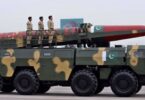SEOUL (AP): North Korean leader Kim Jong Un doubled down on his nuclear arms buildup to overwhelm “hostile forces” at a key meeting where military leaders approved unspecified new operational duties for frontline army units.
Members of the ruling Workers’ Party’s Central Military Commission decided to supplement an “important military action plan” on the duties of frontline troops and further strengthen the country’s nuclear war deterrent, state media said Friday.
North Korea hasn’t specified the new operational duties for frontline army units, but analysts say the country could be planning to deploy battlefield nuclear weapons targeting rival South Korea along their tense border.
While North Korea’s pursuit of nuclear-capable ballistic missiles that could reach the U.S. mainland gets much of the international attention, it is also developing a variety of nuclear-capable, short-range missiles that can target South Korea. Experts say its rhetoric around those missiles communicates a threat to proactively use them in warfare to blunt the stronger conventional forces of South Korea and the United States. About 28,500 U.S. troops are stationed in the South to deter aggression from the North.
Kim during the military commission’s three-day meeting that ended Thursday called for his entire army to “go all out” in carrying out the plans to bolster the nation’s military muscle and consolidate “powerful self-defense capabilities for overwhelming any hostile forces and thus reliably protect the dignity of the great country.”
The commission’s members discussed ways to strengthen the party’s leadership over the entire armed forces and ratified plans for unspecified changes in “military organizational formations,” North Korea’s official Korean Central News Agency said.
Some analysts say North Korea’s possible plans to deploy tactical nuclear weapons to frontline artillery units may require command-and-control changes as the country’s nuclear-capable weapons have so far been handled by the army’s strategic force.
State media reports of the meeting did not include any direct criticism toward Washington or Seoul amid a prolonged stalemate in nuclear negotiations.
The meeting came amid signs that North Korea is preparing to conduct its first nuclear test explosion since September 2017, when it claimed to have detonated a thermonuclear weapon that could be tipped on its intercontinental ballistic missiles.
Experts say North Korea may use its next nuclear test to claim that it has acquired the ability to build a small nuclear warhead to fit its short-range missiles or other weapons it recently tested, including a purported hypersonic missile and a long-range cruise missile. Smaller warheads would also be necessary for the North’s stated pursuit of a multiwarhead ICBM.
While North Korean reports of the meeting didn’t mention plans for a nuclear test, a South Korean government spokesperson said Seoul is keeping a close watch for related developments.
“As North Korea said it discussed and ratified important plans to expand and strengthen its war deterrent, (our) government will prepare for all possibilities while carefully monitoring related trends,” said Cha Duck-chul from Seoul’s Unification Ministry, which handles inter-Korean affairs.
North Korea has already set an annual record in ballistic testing through the first half of 2022, firing around 30 missiles, including its first tests involving intercontinental ballistic missiles in nearly five years.
Kim has punctuated his recent tests with repeated comments that North Korea would use its nuclear weapons proactively when threatened or provoked, which experts say portend an escalatory nuclear doctrine that may create greater concerns for neighbors.
South Korea has been spending heavily to expand its conventional arms in recent years, but some analysts say the country has no clear way to counter the threat posed by Kim’s growing arsenal of nuclear weapons and missiles.
While the Biden administration has reaffirmed U.S. commitment to defend allies South Korea and Japan with its full range of military capabilities, including nuclear, there are concerns in Seoul that Kim’s ICBMs could make the United States hesitant in the event of another war on the Korean Peninsula.
Opinion polls show growing support among South Koreans for a redeployment of U.S. tactical nukes that were withdrawn from the South in the 1990s or even the South’s pursuit of its own deterrent, which some experts say would increase pressure on Pyongyang and create conditions for mutual nuclear disarmament.
North Korea’s apparent push to deploy battlefield nuclear weapons at frontline units had been predicted since April, when Kim supervised a test of a new short-range missile that state media said would “drastically” improve the firepower of frontline artillery units and “enhance the efficiency in the operation of tactical nukes.”
Experts say North Korea’s unusually fast pace in testing activity this year underscores Kim’s dual intent to advance his arsenal and pressure Washington over long-stalled nuclear diplomacy. Talks have stalled since early 2019 over disagreements in exchanging the release of crippling U.S.-led sanctions against the North and the North’s disarmament steps.
Kim has shown no intentions to fully give away an arsenal he sees as his strongest guarantee of survival. His pressure campaign is aimed at forcing the United States to accept the idea of the North as a nuclear power and negotiating economic and security concessions from a position of strength, experts say.






